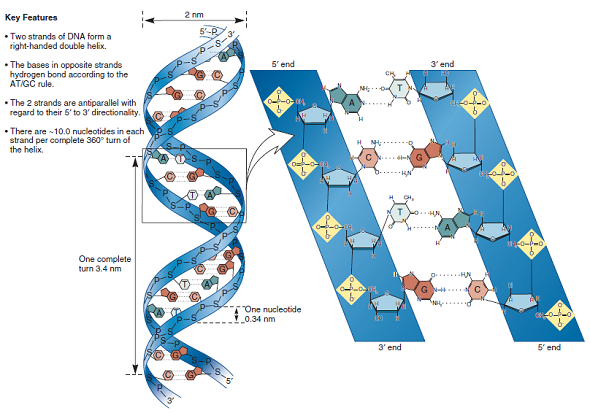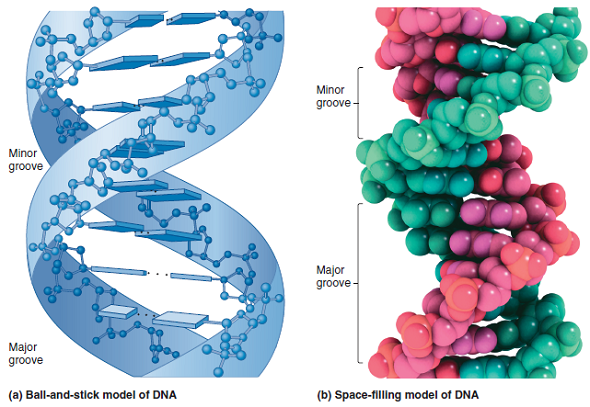
Genetics: Analysis and Principles 5th Edition by Robert Brooker
Edition 5ISBN: 978-0073525341
Genetics: Analysis and Principles 5th Edition by Robert Brooker
Edition 5ISBN: 978-0073525341 Exercise 41
As described in Chapter 15, the methylation of cytosine bases can have an important effect on gene expression. For example, the methylation of cytosines may inhibit the transcription of genes. A methylated cytosine base has the following structure:

a.
Would you expect the methylation of cytosine to affect the hydrogen bonding between cytosine and guanine in a DNA double helix Why or why not (Hint: See Figure 9.15 for help.) Take a look at solved problem S3 and speculate as to how methylation could affect gene expression.FIGURE 9.15 Key features of the structure of the double helix. Note: In the drawing on the left and in the inset, the planes of the bases and sugars are shown parallel to each other in order to depict the hydrogen bonding between the bases. In an actual DNA molecule, the bases would be rotated about 90° so the planes of the bases would be facing each other, as shown in Figure 9.16a.
a.
FIGURE 9.16 Two models of the double helix. (a) Ball-and-stick model of the double helix. The deoxyribose-phosphate backbone is shown in detail, whereas the bases are depicted as flattened rectangles. (b) Space-filling model of the double helix.
a.
Problem S3
Within living cells, many different proteins play important functional roles by binding to DNA and RNA. As described throughout your textbook, the dynamic interactions between nucleic acids and proteins lie at the heart of molecular genetics. Some proteins bind to DNA (or RNA) but not in a sequence-specific manner. For example, histones are proteins important in the formation of chromosome structure. In this case, the positively charged histone proteins bind to the negatively charged phosphate groups in DNA. In addition, several other proteins interact with DNA but do not require a specific nucleotide sequence to carry out their function. For example, DNA polymerase, which catalyzes the synthesis of new DNA strands, does not bind to DNA in a sequence-dependent manner. By comparison, many other proteins do interact with nucleic acids in a sequence-dependent fashion. This means that a specific sequence of bases can provide a structure that is recognized by a particular protein. Throughout the textbook, the functions of many of these proteins will be described. Some examples include transcription factors that affect the rate of transcription, proteins that bind to centromeres, and proteins that bind to origins of replication. With regard to the three-dimensional structure of DNA, where would you expect DNA-binding proteins to bind if they recognize a specific base sequence What about DNA-binding proteins that do not recognize a base sequence

a.
Would you expect the methylation of cytosine to affect the hydrogen bonding between cytosine and guanine in a DNA double helix Why or why not (Hint: See Figure 9.15 for help.) Take a look at solved problem S3 and speculate as to how methylation could affect gene expression.FIGURE 9.15 Key features of the structure of the double helix. Note: In the drawing on the left and in the inset, the planes of the bases and sugars are shown parallel to each other in order to depict the hydrogen bonding between the bases. In an actual DNA molecule, the bases would be rotated about 90° so the planes of the bases would be facing each other, as shown in Figure 9.16a.

a.
FIGURE 9.16 Two models of the double helix. (a) Ball-and-stick model of the double helix. The deoxyribose-phosphate backbone is shown in detail, whereas the bases are depicted as flattened rectangles. (b) Space-filling model of the double helix.

a.
Problem S3
Within living cells, many different proteins play important functional roles by binding to DNA and RNA. As described throughout your textbook, the dynamic interactions between nucleic acids and proteins lie at the heart of molecular genetics. Some proteins bind to DNA (or RNA) but not in a sequence-specific manner. For example, histones are proteins important in the formation of chromosome structure. In this case, the positively charged histone proteins bind to the negatively charged phosphate groups in DNA. In addition, several other proteins interact with DNA but do not require a specific nucleotide sequence to carry out their function. For example, DNA polymerase, which catalyzes the synthesis of new DNA strands, does not bind to DNA in a sequence-dependent manner. By comparison, many other proteins do interact with nucleic acids in a sequence-dependent fashion. This means that a specific sequence of bases can provide a structure that is recognized by a particular protein. Throughout the textbook, the functions of many of these proteins will be described. Some examples include transcription factors that affect the rate of transcription, proteins that bind to centromeres, and proteins that bind to origins of replication. With regard to the three-dimensional structure of DNA, where would you expect DNA-binding proteins to bind if they recognize a specific base sequence What about DNA-binding proteins that do not recognize a base sequence
Explanation
In the given example, methylation occurr...
Genetics: Analysis and Principles 5th Edition by Robert Brooker
Why don’t you like this exercise?
Other Minimum 8 character and maximum 255 character
Character 255



